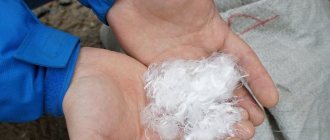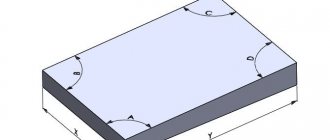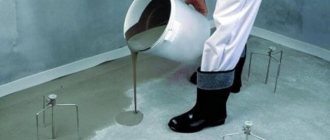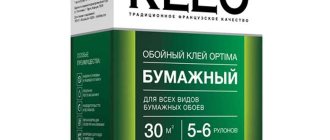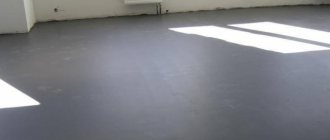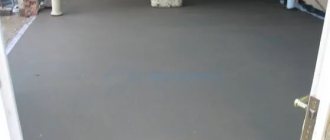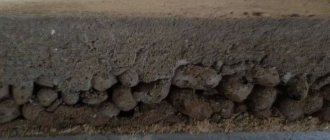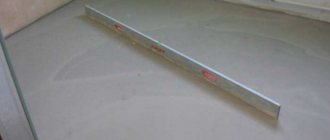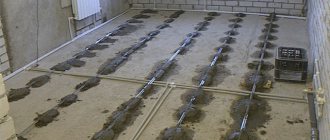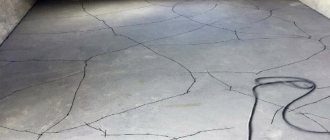Laying a floor screed cannot be done without the dryest mixture, on the basis of which the solution itself is subsequently prepared. But in addition to this, various additives are provided that can give additional qualities to semi-dry screed under certain circumstances. In addition, for a specific type of heated floor, specific plasticizers are provided, which cannot be avoided. To begin with, it’s worth deciding what the positive features of the “applications” for the semi-dry mixture are.
Is it worth using a plasticizer?
Experts recommend using the additive as a basis for heterogeneous compositions and dry construction mixtures, as well as building materials for a wide range of applications. The additive is easy to mix with your own hands, so it is recommended to add it to concrete solutions, including cellular materials. The substance significantly improves the performance qualities of concrete, so it is often used to strengthen reinforced concrete products (reinforced concrete products) in construction.
Summary table of plasticizer testing
Plasticizer properties:
- The substance has inhibitory properties;
Plasticizer quality indicators - Repels water and protects the concrete coating from chemical attack;
- Improves the tolerance of severe frosts (up to -25 degrees) by concrete structures;
- The additive neutralizes the effect of potassium nitrate in an amount of no more than 5% of the total mass;
- Significantly increases the strength of concrete structures without compromising such important parameters as strength and durability. In addition, the substance reduces the setting speed of cement, which contains soluble alkaline materials.
Properties and principle of operation of plasticizers for heated floors
The basis for installing a warm water floor is a strong screed. The operation of the heating system as a whole depends on it.
Concrete mortar prepared in the usual way may collapse during operation due to temperature changes, which negatively affects the functioning of all equipment designed to provide heat in the house.
Therefore, the work uses a plasticizer for heated floors, which increases the physical parameters of the screed.
Is a plasticizer needed and its purpose?
A plasticizer is a component designed to make concrete for heated floors elastic and durable, while the surface is more even and smooth.
This substance improves the solubility of cement clinker, which helps attract particles to each other, pushing air and excess water towards each other, thereby making the mixture more elastic. It turns out to be more dense, which means it dries better, there is practically no shrinkage, and moisture does not penetrate into it.
In addition, the additive protects the concrete coating from deformation under the influence of heat, regardless of the type of heated floor: water, electric or infrared.
For your information! The plasticizer contains only components that are safe for human health, they are non-toxic, and do not have an unpleasant odor.
The main disadvantage of adding an additive to the solution for pouring heated floors is the increase in the cost of the structure, and a more complex installation process, since the mass needs to be in constant vibration.
Main types of plasticizers
Modifiers for dry screed solutions are selected depending on the technology used. Based on their composition, the following types of plasticizers are distinguished:
- liquid mixture of underfloor heating modifiers. Such substances are ready for use without preliminary preparation; they just need to be mixed thoroughly before use. The additive is added to the solution along with water. The required proportions are indicated in the instructions for the material;
- dry plasticizers have a long guaranteed shelf life. Before use, prepare a liquid form of the modifier by adding water in a ratio of 1:2;
- polyamide modifier, exhibits reinforcing properties when added to the screed. After drying, the mixture increases its strength characteristics and does not crack during its entire service life;
- the anti-frost appearance helps the material retain all its properties at low temperatures.
As a rule, the choice of plasticizer depends on the specific operating conditions of the heated floor. If it is necessary to increase the level of homogeneity of the solution, use a solution of a dry modifier, which is quickly introduced into the composition of the building mixture.
Preparing the mixture for screed does not require complex devices; all operations are performed with simple tools in the form of a conventional construction mixer mounted on a drill.
Features and composition of additives
In addition to differences in structure, there are varieties depending on the chemical composition of the plasticizer. It is the presence of these substances that affects the quality of the final solution.
So, many experts note that the additive should contain the following components:
- sodium hydroxide solution;
- formalin;
- phenol-based components;
- sulfuric acid;
- defoamer.
Industrial concrete owes its high characteristics to the presence of plasticizers in its composition.
Correctly selected additives have a significant impact on the mixture for floor screed. It is due to this that a number of necessary properties arise:
- the mixture prepared for work acquires the required viscosity, which ensures a self-leveling effect;
- setting occurs faster;
- Filling activities can be carried out at lower temperatures other than optimal.
On a note! Due to the fact that the components are quite aggressive, contact of the plasticizer with the mucous membranes and skin should be avoided. All work is carried out wearing protective glasses and gloves.
Types of plasticizers
Plasticizing additives are available in two types:
- Dry. The dry plasticizer must first be diluted with water in a ratio of 1:2 (the dosage may vary depending on the type of composition). After this, the mixture is infused for several hours, stirred again and added to the cement mortar for the screed.
- Liquid. Such compositions are sold in cans of various sizes. Before using the component, the packaging should be shaken well and the liquid plasticizer should be added to the mixture along with water. Typically, no more than 2 liters of plasticizing liquid are used per 100 kg of cement.
Important! Before using the plasticizer, be sure to read the instructions included with the solution.
When choosing mixtures for concrete screed for heated floors, consider not only their properties, but also the quality of the additives. The additive label must indicate that the component is compatible with underfloor heating systems. Also consider the manufacturer of the composition.
Advantages and disadvantages
In order for the additive to be effective, it is important to maintain its proportions. This is the only way to achieve a homogeneous concrete mass. Among the obvious advantages of the mixture are:
- Due to the increased density of the solution, heat distribution occurs more evenly.
- Due to the increased density by 10-15%, the layer of concrete screed is reduced.
- Due to plasticity, during thermal expansion the pressure decreases.
- After the solution has completely dried, the surface becomes perfectly smooth. Therefore, there is no need to use additional leveling mixtures.
As for the disadvantages of this additive, the duration of hardening should be noted. But the problem can be mitigated with the help of hardening catalysts. We are talking only about the initial stage of hardening of the screed. In general, the use of a plasticizer has only a positive effect.
Application area
Plasticizing additives are used for the following types of work:
- pouring foundations of various types - from simple strip and columnar to extensive and heavy slab;
- pouring columns, pillars and other reinforced structures;
- installation of bored piles;
- pouring monolithic floors;
- laying bricks, gas silicate blocks, natural and artificial stone
- pouring heated floors;
When pouring a heated floor screed with a concrete mixture with a plasticizer, a high-quality, strong and durable monolithic coating is obtained Source ytimg.com
- façade cladding;
- pouring garden paths, driveways, open summer areas;
- arrangement of swimming pools and artificial decorative reservoirs.
Material composition
Plasticizers that are used for floor screed have different components in their composition, and some manufacturers even try to hide some of the components to create a unique product.
But at the same time, there is a list of main components that are almost always used:
- Waste material purified from phenol.
- Concentrated sulfuric acid.
- Composite (formalin).
- Purified water.
- Substances that contribute to the extinction of foam.
- Caustic soda in liquid form.
Due to this composition, it is possible to achieve the required homogeneity of concrete, as well as to avoid the formation of air pockets inside the floor during pouring. The screed for a warm electric floor does not allow any cracks, air voids or gaps at all. Such costs of concrete screed can lead to the fact that in empty areas the cable begins to overheat and the system may suffer due to a short circuit. If you plan to lay an electric cable floor, then you MUST use a plasticizer!
What are the requirements for plasticizers?
These substances must have good compatibility with the selected brand of cement so that upon interaction the mixture acquires the necessary plastic qualities. The additive must have low volatility and no odor. The plasticizing substance must have high chemical inertness. Also, the plasticizer should not be released from the polymer under the influence of liquids and oils.
Plasticizers for heated floors are used in the manufacture of:
- warm and self-leveling floors;
- screed;
- industrial floors;
- floor slabs.
In addition, these additives are used for interior and exterior surfaces.
The inclusion of a plasticizing additive in concrete allows construction work to be carried out at both fairly low and high temperatures. The addition of plasticizers allows work to be carried out at temperatures from + 5 C to +35 C.
Screed for heated floors is prepared using liquid, powder additives, and emulsions. The tile adhesive contains a plasticizer in the amount required for preparing a heated floor.
The screed for heated floors includes: one part cement, three parts coarse sand (0.5 to 0.8 mm in size) or fine gravel. The cement and filler are pre-mixed. The plasticizer is added to half the recommended volume of water, carefully added to the mixture of sand and filler, and mixed. The rest of the water must be added to the composition in portions until a thick viscous consistency is obtained. The average consumption of liquid plasticizer is from 400 to 800 milligrams per 1 m2 of surface.
A screed for a heated floor using a powder plasticizer has the same composition as with a liquid plasticizer, but with the addition of polyamide reinforcing fibers.
Today, mixtures for pouring heated floors are usually sold in finished form in hardware stores. Purchasing ready-made building mixtures will allow you to quickly and easily fill the floor, but will significantly increase the cost of the work.
If necessary, plasticizers for pouring heated floors may have additional characteristics:
- the presence of a hardening accelerator for cement mixtures;
- an additive that increases the density of concrete during freezing and thawing (can increase the strength of concrete by 20 - 30%);
- additive for surfaces that will be used in conditions with increased corrosion load, for example, in swimming pools;
- anti-frost hardening accelerator, increases the early grade strength of concrete, accelerates hardening and allows work to be carried out at temperatures down to minus 15 C;
- anti-shrink effect.
Plasticizer for concrete: improving the solution
Concrete is a strong, reliable and durable building material. However, it has limited ductility. In difficult working conditions, when creating non-standard shapes, to impart additional qualities in special designs, specific components are added to the solution, which modify the structure of the mixture.
To make a plasticizer for concrete with your own hands, we suggest that you familiarize yourself with the known types of additives that are available to every builder.
Additive functions
The main tasks of the plasticizer are as follows:
- Reduces the concentration of water in the solution. In this case, the composition does not become dry, does not crumble or gather in lumps, but changes qualitatively. The plasticizer precisely binds moisture particles to the dry substance, which makes the solution plastic. This is the main function, due to which water consumption is reduced and the quality of pouring is improved.
- Having the ability to bind particles of different states of aggregation, the plasticizer does not allow the solution that has not yet hardened to separate (usually part of the liquid is released on the surface).
- Good adhesion also occurs with reinforcing elements, which are used in the form of a fibrous component or metal screed with rods, pipes, etc.
- Some plasticizers also act as a protective component of the composition: they create a structural barrier, due to which concrete becomes less susceptible to atmospheric conditions.
- Poor quality cement from the manufacturer, errors or incorrect combination of components in the ratio of the solution are the causes of cracks and crumbling of the surface layer of hardened concrete some time after pouring. The plasticizer prevents these destructive processes.
- The additive isolates the concrete structure from moisture penetration, which is important on heaving soils, in conditions of high humidity, or when sewage or groundwater passes through the soil.
- Plasticity not only improves the efficiency and productivity of work, but also allows you to create complex shapes from cement mortar. This is useful when performing plastering work, pouring in hard-to-reach places, as well as in implementing design and architectural solutions.
Cleaning agents as plasticizers
Additives to the solution are not secret chemical compounds at all. It is easy to find and prepare a plasticizer for concrete using products that were not originally intended for this.
The method of adding egg whites to the mixture is already a thing of the past, but simple liquid soap is still “in trend” among plasticizers. The option is cheap and easily accessible, but it also has disadvantages, for example:
- Soap dissolved in water is essentially an alkali, which, due to its chemical properties, is capable of displacing some weak salts from the mixture. As a result, white streaks may appear on the surface of the layer, indicating such decomposition.
- Cleaning products are a mixture of several chemical components, each of which has a different effect on the structure of concrete. For this reason, the rate of hardening and setting of the solution changes.
- Soap has only a temporary plasticity effect; does not serve as a moisture insulator and does not remove water from the composition.
- Other physical properties of concrete deteriorate. For example, micropores do not form in the structure, which prevents good shrinkage of the building element.
Almost any cleaning agent can be used as an additive, the main thing is to follow the recommendations for concentration and method of addition. The plasticizer for concrete is mixed as follows: if the product is liquid or jelly-like (like “trialon”), the solution should be supplemented with it along with the addition of water, but if it is a powder, it is better to first dilute it in water, and then fill the mixture. The correct concentration of plasticizer is no more than 1 glass per 50 kg of cement.
Specific additives
An equally cheap and accessible component is slaked lime. At the same time, the plasticity of concrete increases much more effectively. The additive significantly reduces cracking and is in demand for bricklaying and plastering.
The disadvantage of using slaked lime is the insufficient strength of concrete. When using such an additive, it is better to limit yourself to lightweight building structures.
This plasticizer has different concentrations when performing different types of finishing work. For internal plastering, the density of lime in relation to the volume of cement is 100% (1 cubic m / 1 cubic m). In a solution for external use, the concentration of lime drops sharply to 1:6. Before adding to the general composition, the plasticizer should first be diluted in water until the mixture acquires a “jelly” state.
In floor and ceiling mortars, liquid glass is used as an additive, which not only acts as a plasticizer, but also performs a protective function. A small amount of the component (in a ratio of 1:50) effectively repels moisture and creates a high-quality barrier to precipitation and aggressive chemicals.
PVA glue has long established itself as a good plasticizer. This product is used for many construction jobs, so finding it is not a problem. The peculiarity of a solution with polyvinyl acetate is its rapid hardening, which is invaluable in conditions of “urgent” work, for example, when plastering walls and ceiling surfaces.
The glue is afraid of low temperatures and moisture, but, which is not typical for PVA, when it adheres to cement particles, the influence of ultraviolet rays turns out to be neutral. For high strength cement (grades 400-500) the recommended concentration is 1:5...6. First, it is better to thoroughly mix the solution, and then add glue.
Source: https://besedkibest.ru/osnovanie/plastifikator-dlya-betona-svoimi-rukami/
Complex Supplements
Additives for cement and concrete are selected depending on what properties need to be obtained. But what if you need multiple properties? In this case, complex additives will help, which contain several components and give concrete a complex of properties. Complex additives include, for example, a superplasticizer - an additive that combines all properties.
Video: Effect of plasticizer C3 on the consistency of the solution
The superplasticizer increases the mobility and strength of concrete, imparts frost resistance and ensures the possibility of long-term transportation of the solution.
Video: Operating principle of superplasticizer
The best manufacturers of plasticizers
Construction stores offer a fairly wide selection of various additives, so deciding which brand is best to choose is not so easy. To simplify this task, we offer you the highest quality formulations that are most popular today.
Sanpol (Ukraine)
The Ukrainian manufacturer produces liquid plasticizers that improve the thermophysical properties of the base for heated floors. In addition, the composition improves the resistance of the slab to mechanical damage.
The manufacturer's recommended proportion for mixing the solution is 0.2 liters of additive per 400 kg of cement. Such a liquid plasticizer costs about 140 rubles per liter.
ArmMix (Russia)
Another high-quality liquid plasticizer is offered by. The main advantage of this solution is that it increases the water resistance of the concrete coating by 4 steps, and this is an important advantage when installing water-heated floors. It is also worth noting the high frost resistance of the solution, thanks to which work can be carried out at sub-zero temperatures.
To mix, you need to mix 1 liter of ArmMix per 100 kg of cement. The cost of the additive is 100 rubles per 1 liter.
Warm floor HLV-75 (Ukraine)
Dry and liquid plasticizing compositions are suitable for self-installation of the base for warm, water and electric floors. For 100 kg of cement, about 0.5 kg of substance is consumed.
Unlike analogues, this composition does not slow down, but, on the contrary, accelerates the hardening process of concrete by 3 times. The plasticizer costs 620 rubles for 2 kg of dry mixture.
Rehau (Germany)
Despite the fact that the supplement from a renowned manufacturer costs 3,000 rubles per 10 kg, the products of this company are deservedly considered the best. Rehau plasticizers are available in both liquid and dry forms. In addition to its main characteristics, this composition is highly environmentally friendly, so when heated, it will not harm human health in any way.
The additive can significantly increase the thermal conductivity of the rough base for heating elements.
Superplasticizer S-3 (Russia)
The premium liquid additive is produced by analogy with the German plasticizer brand “Mighty 100”. The domestic composition is in no way inferior to the foreign “source” and is distinguished by the same high strength characteristics.
However, it is worth paying attention that this plasticizing component contains phenol, formaldehyde and naphthalene derivatives. Therefore, before using it, be sure to check with the seller at what temperatures the selected component will be safe for your health.
The proportions of S-3 are almost the same as those of analogues - no more than 1.5-2 liters of plasticizer are used per 100 kg of cement. The cost of the additive is about 1,000 rubles per 10 liters.
If you wish, you can make the additive yourself, but it is worth considering that in this case the positive properties of the additive will be minimal.
Criterias of choice
- liquid mixture. The composition is first thoroughly mixed and added to the solution along with water in a ratio of 1–1.5 l/100 kg (additive/dry cement).
- dry mixture. The principle of using these compositions is almost the same, with the exception of the initial stage. The dry modifier is pre-mixed with water in a 1:2 ratio and the solution is allowed to settle.
READ MORE: Installing a floor in a bathhouse with your own hands: a step-by-step guide
For small volumes, use a construction mixer. After mixing is completed, the solution should settle. In 20–30 minutes, large particles manage to sink to the bottom. Therefore, the solution is additionally mixed and most of them are crushed. Secondary settling is carried out and pouring begins. The solution, which is more liquid than standard concrete, fills all voids, providing reliable protection of heating elements from mechanical loads.
Important
It is prohibited to turn on the heating until the hardening process is complete.
Any plasticizer is a highly active substance, which is why it is so important to adhere to all the manufacturer’s recommendations set out in the instructions attached to the mixtures. Work is carried out in warm weather at a temperature not lower than 5ºС.
- performance characteristics;
- consumption.
On a note
The average consumption of modifiers is 0.5-1 liters of the finished mixture per unit area. In the case of cheap brands, this expense increases, sometimes even significantly.
Among modern dry mixtures for screed, there are options that initially contain modifying components that also effectively provide the necessary qualities.
The range of plastic additives is quite wide. However, among them there are the most popular ones.
Sanpol. The liquid mixture has a positive effect on the thermophysical characteristics of the screed and improves mechanical strength. When using it, the need for water is reduced by 10-15%. Pouring screed, especially for a less experienced performer, is not an entirely simple process. Another advantage of Sanpol is that the initial setting of cement requires sufficient time, which is enough to correct pouring errors. The required ratio of modifier and cement is 0.2 l: 400 kg.
ArmMix. The manufacturer of this product is Thermoplast company. The only difference with Sanpol solution in use is the ratio of components - 1 l : 100 kg. You can also pour the solution with ArmMix at negative temperatures.
S-3. This is a superplasticizer. High-grade concrete is used with this liquid plasticizer. In this way, a double effect is obtained: strength characteristics are improved and cement consumption is reduced.
Advice
When mixing, you should adhere to a proportion of 1.5-2 liters per 100 kg of cement.
Rehau. A premium product is added to solutions (10 g per kg) to create thin and medium-thick concrete layers for underfloor heating.
Which plasticizer for heated floors will be optimal to use? First of all, you need to take into account the characteristics of the room - area, temperature of the subfloor, screed height, etc. Based on these data, a suitable composition is selected.
Not all types of plasticizers are used to install heated floors on screeds. The main points when choosing an additive are the marks on the packaging, which indicate that the product is intended for installation of heating systems.
Also, when selecting a plasticizer for a floor screed in which heating equipment is installed, the following factors are taken into account:
- quality and manufacturer of the composition for improving the properties of cement mortar;
- additive consumption;
- performance characteristics;
- type of plasticizer – dry, liquid;
- absence of harmful components;
- price.
When choosing a plasticizer for a heated floor, take into account the consumption of the additive.
When choosing a plasticizer for a floor heating system, the type of heating equipment itself is taken into account. If the installation of an eclectic device is planned, then a dry additive is used for the screed. When mixing a solution intended for water heated floors, it is recommended to use liquid plasticizers.
Safety rules when working with plasticizers
These construction additives can cause irritation to the mucous membranes of the eyes and respiratory system. When using them, personal protective equipment must be used. Use respirators to protect your lungs and safety glasses to protect your eyes. Wear rubber gloves when working to avoid getting the composition on your skin.
Instructions for use
Working with any plasticizer to form a concrete heated floor screed is carried out in several stages.
- To begin with, the additive is introduced into the sand-concrete mixture or any other solution that is used to form the coating. This must be done correctly, simultaneously with the introduction of all other components, avoiding an overdose.
- After this, the main components must be thoroughly mixed for about an hour and a half. It is best to use a concrete mixer for this. If such a device is not available, you should use a drill with a special attachment.
- The finished composition can be taken to fill a coating for any purpose - for installing hidden heating systems or insulating residential premises. The fundamental point is that when working with the solution, you need to evenly redistribute the mixture over the entire surface, since the strength, reliability and durability of the base will directly depend on this.
- At the final stage, it is necessary to create a filling layer; it will ensure maximum hardening. If the humidity level in the room is low, then after 7-10 days the surface will be ready for the rest of the construction and installation work, namely for laying the decorative finishing coating. After another couple of days, it will be possible to place heavy furniture on the flooring without fear that the surface will deform.
For a review of the CemThermo+ brand plasticizer, see below.
Short description
The higher quality and better the cement layer, the more effective the heating of the rooms will be. When pouring a heated floor, you will need good quality concrete, and this is difficult to achieve without using a plasticizer for the screed. The sand-cement mixture used does not have all the necessary technical and operational characteristics to ensure truly effective operation of underfloor heating. The design of underfloor heating itself is characterized by temperature changes in the cement layer, which sooner or later will provoke a violation of integrity and the appearance of microcracks. In addition to the destruction of the concrete itself, the finishing flooring (decorative stone, tiles, etc.) is also deformed, and sometimes even disturbances in the performance of the heat source appear, not to mention the fact that it is very difficult to obtain complete solidity of the poured layer from a standard mortar.
If, when laying the mixture, air pockets are formed, this entails a decrease in the functionality of the floor heating system as a whole. Floor plasticizer can be bought at any hardware store, and this is the right choice, as it will make the concrete mixture better and more homogeneous, and this will have a beneficial effect on the pour.
The mixture becomes plastic, and due to its universal composition it receives additional pleasant properties:
- Increased performance characteristics.
- Waterproofing.
- High adhesion rates (this is the ability to bond with different materials).

